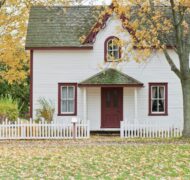Home
Book / Produced by partner of TOW
The word home has a broad range of meanings. On a personal level, it can refer to our immediate and physical place of residence; this may be a house, an apartment or condominium, a studio, boarding house, trailer park, retirement community, college dormitory or even a street corner. Home can also be descriptive of our “roots”; the place in which we grew up; our town, city, state or country of origin. Quite apart from a sense of place, home can describe the welcome and embrace of close friends or family members with whom we have a shared history. Or it can be descriptive of something for which we long; either that which we once had and desire to re-create or that which we have never experienced but ardently dream of.
Whatever definitions we use, our experiences of home, both past and present, are deeply formative. For some, home conjures up warm and secure memories of the past or is representative of all that is good and wholesome in the present. For others, to speak of home is to resurrect past, painful experiences, a reminder of what one never had or does not have. As we face the ever-present realities of family dysfunction and breakdown, economic struggle and the increasing pressures of urban life, we are confronted with the fact that our experiences of homes, both positive and negative, shape who we are. We are products of our homes.
Also, regardless of culture, we cannot avoid the vitality of the home as the expression of what it means to be human. Home gathers up so many of our deepest physical, emotional and spiritual needs and gives flesh to our longings and hopes for the future. In the United States homeownership, a privilege out of reach for many, is still central to the “American dream,” for it stands as a monument to our drive for independence and our cravings for security and belonging.
The Home in the New Testament
In line with the Old Testament emphasis on the home as a place of protection, for raising a family, for rest, prayer and hospitality, and as part of one’s legacy to one’s children, the home in the New Testament plays a prominent role in the ministry and mission of Jesus, and in the unfolding story of the early church.
A Place of Spiritual Encounter. Though it is true that Jesus ministered and proclaimed in synagogue and temple, his favored place of ministry was the home. There was nothing that Jesus did in the name of the Father that he was not prepared to do in the home. His choice of home as a primary place of interaction is consistent with his incarnational mission; no longer was the presence of God confined to the temple, mediated by priests, but it was now the immediate and daily experience of all those who respond in faith. And that presence was encountered in the most ordinary settings, the home included.
Spiritual encounters take many forms. In the New Testament God was encountered and responded to through healing and deliverance (Matthew 8:14-17; Mark 2:1; Mark 5:35-43; Luke 14:1-4), worship and prayer (Matthew 2:1; Matthew 26:6-13, 30; Luke 1:39-55; John 12:1-8; Acts 2:1-4; Acts 12:12), and through hearing and receiving from God (Matthew 1:20; Matthew 2:13; Luke 2:6-38; John 19:19-23; Acts 2:1-4; Acts 9:11). All these happened in the home.
A Place of Community. As community is vital to the Christian church, so in the New Testament the home is vital to the nurture of community. Jesus spent a substantial amount of time in homes building relationships. One of his favorite activities was eating and drinking in the homes of his friends (Matthew 8:15; Luke 10:38-42; John 12:2). The Passover meal he shared with his disciples in a home prior to his crucifixion (Luke 22:7-38) signified the beginning of a tradition that is still today the mark of community in the Christian church.
As we examine the life of the early church, it is apparent that the home played host more than any other venue to the development of community (Acts 2:42-47). The early church was almost exclusively a network of house churches (Romans 16:3-5; Col. 4:15; Philemon 2). Without the house as a meeting place for teaching, fellowship, worship and mission, it is hard to imagine how the early church would have found its feet.
A Place of Ministry. As well as playing host to the initial process of cohesion among the earliest believers, the home was the place where the open invitation into God’s kingdom was extended to all who would hear. Jesus chose to do much of his teaching and preaching in homes, most often while reclining at a meal table (see Eating), sharing his time with “tax collectors and `sinners’ ” (Luke 5:30; Luke 15:1-2; Luke 19:5-7). He visited and ate with Samaritans and saw many become his followers (John 4:39). He confronted the Pharisees in their homes (Luke 11:37-38; Luke 14:1-6) and he welcomed into the home prostitutes, the demon-possessed and the sick (Matthew 8:16-17; Matthew 26:6-13; Mark 2:1). The home was the place where Jesus took his disciples aside to explain and instruct (Matthew 13:36-52; Matthew 17:25; Matthew 18:35). The home was where Nicodemus came seeking truth (John 3:1-21), and it was where the crowds gathered to hear Jesus preach (Mark 2:1; Mark 3:19-21).
The home played host to the beginnings of the church (Acts 2:14). Early and rapid growth was centered in the home (Acts 2:46). As the persecution of the church moved from “house to house” (Acts 8:3), so the preaching of the good news happened “house to house” as well (Acts 5:42; Acts 20:20). The opening of the church to the Gentiles sprang from events in the home (Acts 10:25-48), and Paul’s subsequent mission to the Gentile world could not have happened without the network of households that extended hospitality to him during his journeys (Acts 17:5; Acts 18:2-3; Acts 20:7-12; Acts 21:8, 16).
A Place of Expectation. As we examine the role of the home in the New Testament, two realities emerge. Jesus existed very much in the present. He was the presence of God in physical form, to be touched, seen and heard. Wherever he went, he embodied the immediate concern of the kingdom for the here and now. Just as God in flesh was not a mere convenience but a vital theological reality, so Jesus present in the house was not an irrelevant aside but a tangible expression of God in their midst. All the concerns, duties and relationships embodied in the house were gathered up into the concerns of the kingdom. This is obvious from the number of stories of household duties and objects Jesus told to explain the nature of the kingdom of God (Matthew 7:2-24; Matthew 25:31-46; Mark 10:29; Luke 11:5-10; Luke 14:7-14; Luke 15:8-10). The concerns of the earthly home were not cast aside by Jesus in favor of gazing off into the future. Rather, the kingdom was understood as present and immediate, even in the home.
On the other hand we have Jesus’ promise that he goes to prepare a place for those who believe, a home with many rooms (John 14:2). This is part of the kingdom yet to be. It is with this sense of the kingdom now and not yet, the present reality of the home and the home yet to be, which validates the tensions felt by those endeavoring to live fully in the present and yet fully anticipating. Author Wendy Wright describes the human longing for stability and caring—the longing for home and the longing for meaning and ultimacy—the longing for homecoming. It is somewhere in between these two realities that believers are called to live.
Contemporary Attitudes Toward the Home
While for a majority of people in newer Western societies owning a home, especially a house, is part of their “dream,” fewer and fewer are able to afford this. In the United States the number is less than 60 percent. Where homes can be purchased, mortgages now take up an average of around 40 percent of income, up 15 percent from a generation ago (see Debt). This is partly due to inflation in house and apartment prices and partly to the increased size of houses and apartments today. Mortgages often tie up people’s income for a large portion of their working life, with the result that most people are in debt over accommodation requirements for most of their lives.
Despite people’s longing for “a home of their own,” as in the past but even more so in the present, they tend to view where they live as a temporary resting place. Because of high mobility, most people pass through many dwelling places during their lifetime. The phenomenon of the “mobile” home is simply the latest expression of this. In many cases, both marriage partners are now working outside the home. Domestic space is therefore generally empty during the day and often on weekends, though the appearance of telecommuting is having a small effect on this.
Yet the idea of home remains strong. Most people see having a home as essential for their contentment or fulfillment, as a basis for security and stability, and as a fortress of privacy or “haven in a heartless world” (Lasch). They also tend to view their home as a status symbol, as an extension of their personality or as an opportunity to have a taste of nature on their doorstep. For some it is primarily an investment. Our homes, therefore, are significant to us in a variety of ways. That explains why they occupy so much of our attention and mean so much to us.
We are now living in a time when suburbia, the main context for the places people live, is undergoing change and reconsideration. It is not simply a case of fewer people being able to live there, or the urbanizing of many suburban settings, but the way suburbia has strengthened the gap between private and public life.
Architects and sociologists are voicing their common concern that the way we have been planning and building urban neighborhoods has disregarded the balance necessary to a well-functioning society between the home as private space and the home as a place of community. In his book A Better Place to Live: Reshaping the American Suburb, Philip Langdon argues that since the end of World War II, the front porch as the place of community interaction and the focus of family activity has been overtaken by the secluded back yard, complete with pool and barbecue area. Take a drive through any new housing development and you will find the front façades of the houses dominated by two- and three-car garages, with the main entrance to the home hidden off to the side. In many cases sidewalks no longer exist, and public gathering places are a secondary concern. According to Langdon and others, personal convenience and privacy now determine the architecture of our homes. Neighborhood considerations are of lesser concern. The proponents of New Urbanism contend that the way we build our homes must reflect to a greater extent the fact that we are community and public beings.
A Christian Response
The question must be asked: As those seeking to integrate our Christian faith with all of life, how do we interpret God’s purposes for the home, and how do we nurture our homes of today and tomorrow as places of God’s presence? Apart from our recognition of our thankfulness for God’s providential provision of “a roof over our heads,” we should consider the following dimensions of the homes in which we live.
A Sacred Place. When one considers, as we have, the range of significant events to which the home played host—the incarnation, the commissioning of the disciples, the last supper, the resurrection appearances, Pentecost, the opening of the church to the Gentiles, the blossoming of the early church—it is hard to deny the home its role as a place of God’s gracious and transforming presence. God’s presence through the Holy Spirit can form, nurture, refresh, heal and call us, and it is ours to be experienced in the home. The Roman Catholic Church’s post-Vatican II declaration of the family as “domestic church” reminds us of the sacredness of place and interaction in the home. Unfortunately, we do not often appreciate the very immediate, divine presence that surrounds us there. It is our challenge to find ways to recognize and respond to the presence and call of God, and to experience in the solitude and relationship of the home the immediacy of “God with us.”
A Place of Relationship. The traditional bonds of community are a fragile thing in today’s world. This is certainly true in the home. As our lives become more fragmented, finding time together as households is increasingly difficult. Shared mealtimes are often sacrificed in the interests of individual agendas. More often than not, the television is the gathering point in the home, an object that discourages rather than nurtures communication. If we are serious about the home as a place of interaction, then careful thought should be given to some practical matters of priority. Creating common schedules that prioritize time together is essential. Consideration could be given to the arrangement of furniture in common areas. Too often the television set is the organizing point in our living rooms. Placing it elsewhere and intentionally creating spaces that invite interaction through the simple rearrangement of chairs and lighting can make a substantial difference.
A Place of Refuge. While in the majority of instances recorded in the New Testament the focus of home ministry and interaction is on the open door, there are also significant instances of the house as a place to close the door on outside demands (Matthew 6:6; Matthew 8:14; Mark 5:38-43; Luke 1:24, 56). There will be times in the life of every household when it is more appropriate to focus on the healing and well-being of those within than to extend a welcome to outsiders. The various seasons of life each come with their unique challenges and demands. Our homes must serve as places of refuge, withdrawal, healing, comfort and solitude to varying degrees throughout our occupancy. Sensitivity to the changing needs of our household members must always be seen as a valid expression of our response to God’s call. It is interesting to note the occasions in which Jesus directed one of those he healed to “go home” (Mark 5:19; Mark 8:22-26; Luke 5:25). He did not direct them to go and do, go and proclaim, or go into all the world: he simply commanded them to return to their homes.
A Place of Mission. In a society that values independence and privacy, it is perhaps our greatest challenge to stand apart, to model the welcome and embrace of the gospel where we live. The call to mission is a call to friendship. Such a call requires an open door, inviting conversation and redemptive relationship. The church is often rebuked for being more a fortress that guards the faith than an open table to which all are welcomed and where faith is shared. The home is ideally suited to model the latter. An integrated Christian faith is a key issue here too. Our place of worship and fellowship is most often separate from our place of living. In today’s urban world the two can be not only in different buildings but in two completely separate parts of the city. Many today are rediscovering the New Testament house-church model (see Church in the Home), which helped tremendously in reintegrating these separate worlds and in recentering the home as a primary place of mission in the world. Where possible, we can also use our homes as places for exercising hospitality to those who are traveling or on vacation, those who are engaged in itinerant ministry or home from overseas mission, and those who are temporarily homeless. While not everyone is able to have a guest room available to any who may need it, those who can afford to do so can provide one as a tangible sign of their welcoming attitude to others.
A Place of Recreation. The home is a place where we can relax, be ourselves, rest and enjoy leisure. It provides opportunities for play with our families, and for creativity in the way we decorate and furnish—not necessarily an expensive affair, as the simple but beautiful and peaceful homes of many Mennonites and rural folk attest. The home is a context in which many people pursue their hobbies and crafts, extending and enriching themselves in satisfying ways that may also be beneficial to others. The uncertainty or chaos of the world outside is sometimes compensated for by the stability and order of the home. Meanwhile, the space around the house allows people to re-create the earth through sowing and planting flowers, shrubs and trees (see Gardening). In some cases the front and back yards of a home become a miniature Garden of Eden that signals to us our longing for the coming Heavenly Garden City (Rev. 22:1-5).
Conclusion
In light of these considerations, we should consider carefully not just where we should live but where God wants us to live. First of all, this requires understanding our calling, for this will have much to say about where we should reside. In deciding this we need to take into account our location with respect to our work, schools, parks, the needy and public transport.
Second, we should think through what kind of home we need rather than what kind of home we want, which is often not much different from what most others desire. How much should we be governed by the principles of simplicity (see Simpler Lifestyle), of stewardship of God’s creation, and, if we are able to build a home, of its compatibility with other dwellings, integrity in terms of style, and quality in terms of craftsmanship?
Third, we should give thought to having and arranging spaces inside the home so that they serve their proper function and are an expression of our values and priorities. Do we want our home to be a showcase to impress outsiders, or do we want it to be a place that nurtures relationships and provides security for those who live there? Do we want our home to be a perfect example of orderliness and tidiness, or do we want it to be a place of welcome, embrace and peace for the visitor? Do we want it to open up to the creation around it and the street on which it is placed, or seal us from these?
Instead of assuming that the single-family home or individual apartment is the embodiment of our personal desires and needs, we should also consider the benefits of cooperative housing or shared living arrangements, such as friends buying or renting adjoining houses, or living with others in a Christian community. Congregations can also give thought to helping young families put a deposit on their first home, developing a street community where members live near one another and intentionally minister to their neighborhood, or providing low-cost housing for seniors.
In summary, the home is indeed, potentially at least, a sacred place in which the presence and purposes of God can be discovered and responded to. As a people who long for the fulfillment of God’s promise of an eternal home to which we are welcomed with open arms, we have the opportunity in the present moment to experience and to be “the household of God” (1 Tim. 3:15 NRSV). Our homes can be gathered up in that experience.
» See also: Church in the Home
» See also: Hospitality
» See also: Suburbia
References and Resources
C. Alexander, A Timeless Way of Building (New York: Oxford University Press, 1979); R. J. Banks, Paul’s Idea of Community (Peabody, Mass.: Hendrickson, 1994); T. Howard, Hallowed Be This House (San Francisco: Ignatius, 1976); T. Kidder, House (New York: Houghton Mifflin, 1985); P. Kratz, The New Urbanism: Toward an Architecture of Community (New York: McGraw-Hill, 1994); P. Langdon, A Better Place to Live: Reshaping the American Suburb (Amherst: University of Massachusetts, 1994); C. Lasch, Haven in a Heartless World (New York: Basic Books, 1977); C. C. Marcus and Sarkissian, Housing As If People Mattered (Los Angeles: UCLA Press, 1986); W. Rybczynski, Home: A Short History of an Idea (New York: Viking, 1986); J. Solomon, The Signs of Our Time (Los Angeles: J. P. Tarcher, 1988); J. F. C. Turner, Housing by People: Towards Autonomy in Building Environments (New York: Pantheon, 1976); J. A. Walter, The Human Home: The Myth of the Sacred Environment (Tring, U. K.: Lion, 1982); W. M. Wright, Sacred Dwelling: A Spirituality of Family Life (New York: Crossroad, 1990).
—Simon Holt and Robert Banks





